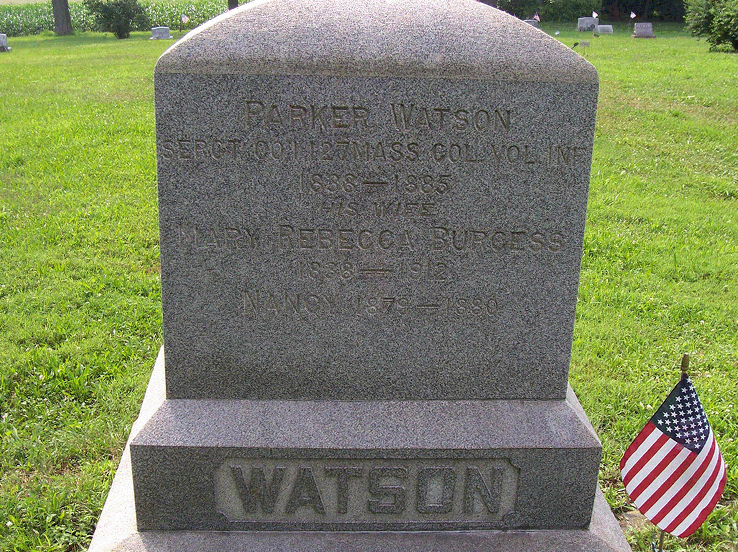

After the Civil War, whites' portrayals of African-Americans in Franklin County often harkened back to imagery of the antebellum South, rather than to the multi-racial alliance that had defeated the South militarily. Such historical amnesia contrasted with African-Americans' own, vivid memories or commemoration of the war and its legacies. This section presents advertising devices and other images, as well as texts. |
|
Remembering African-American Veterans After the Civil War Franklin County whites offered prominent recognition of the wartime experiences of Franklin County blacks only belatedly. In some major historical venues of the postwar era, whites rendered invisible the African-American Civil War experience. In 1896, Chambersburg hosted a meeting of the Department of Pennsylvania, Grand Army of the Republic (GAR), an organization of Union veterans. Attendees at the meeting received this printed program. It referenced neither African-American veterans, despite their formal membership in GAR groups in Pennsylvania, nor battles like Battery Wagner, where African-Americans from Franklin and other Pennsylvania counties made dramatic sacrifices. As the program shows, Howard's lecture on Gettysburg emphasized that battle's "thrilling incidents" rather than its influence upon Abraham Lincoln's proclamation there of "a new birth of freedom," notwithstanding Howard's own role in further redefining "freedom" as the head of the Bureau of Refugees, Freedmen and Abandoned Lands.1
The amnesia prevailing at some, white-dominated venues contrasted with African-Americans' own, vivid commemoration of the new birth of freedom during the Civil War and with their memorialization of blacks' sacrifices on behalf of that freedom.
In Mercersburg's African-American Cemetery, the positioning of the text on this headstone suggests that the family of Parker Watson prioritized memorializing his Civil War service in the 127th United States Colored Infantry (replacing "United States" with "Massachusetts" on the inscription) even over memorializing his birth and death dates. The decade between 1860 and 1870 had seen Watson transition not only from citizen to soldier but also from laborer to farmer. This stone also marks the final resting places of Watson's wife, Mary Rebecca, and evidently a child, Nancy.  Representations of African Americans in Popular Culture Late in the nineteenth-century and early in the twentieth, racialized commercial imagery comprised a common feature of life in Franklin County, reinforcing the barrier between the story of local blacks' Civil War military service or civilian experiences and local whites' recognition of that story.
Bolding v. Hasskarl African-Americans rebutted such imagery with special fervor when a white Chambersburg pastor exceeded even the demeaning duty-and-burden imagery by denying blacks' humanity altogether and supporting his assertion with interpretations of the Civil War and other "evidence." In 1898, Reverend G. C. H. Hasskarl, the pastor of Chambersburg's Second Lutheran church, published his assertions of "a radical difference" between African-Americans and people of other races. Hasskarl claimed African-Americans possessed inferior mental and physical characteristics arising from their descent, not from Ham or the other progeny of Adam and Eve, but from a beast that found safety on Noah's Ark by assuming the "form" but not the substance of humans. For Hasskarl, the Civil War was a catastrophe unleashed by the ascension of a nonslaveholder to the Presidency. Previously, Hasskarl claimed, the United States had enjoyed "peace, prosperity, happiness and glory" because its greatest leaders--slaveholders all--recognized the nonhuman status of African-Americans and God's ordination "that the Negro should be the 'servant of servants' solely."3
Bishop A. Walters of the A. M. E. Zion Church and Reverend B. J. Bolding of Chambersburg's A. M. E. Zion Church, both African-Americans, took up the challenge in Hasskarl's pamphlet to "[a]ny critic desirous of controverting successfully the central truth" of his attack on the literal humanity of black people.4 Walters expressed astonishment that someone like Hasskarl, "with any degree of intelligence, with the facts of history before him and with examples of intelligence and moral manhood in ebony hue on every side" could "manifest the most malevolent spirit." Walters emphasized logic in an initial refutation of Hasskarl, during a speech before the New Jersey State Convention of Christian Endeavors in 1898.5 In 1906, Bolding issued a second refutation, in pamphlet form and with Walters authoring the introduction. (Hasskarl had previously issued at least one, expanded reprint of his argument.)6 Echoing Walters, Bolding employed logic and science as well as scripture, noting the impossibility of the outwardly human/inwardly non-human hybrid whose existence Hasskarl had hypothesized. In the pamphlet's concluding pages, Bolding added that Haaskarl's effort to blame Civil War calamities on African-Americans bore no relation to the fact that the war, as Bolding understood it, neither began nor was initially fought "to free Negroes." "[I]f the Union could have been preserved without emancipating the Negro we would still be in chains and sold from the auction block." In the end citizenship, not servitude, for all African-Americans was accomplished divinely (in the 1860's): "God who rules put it into the hearts of the President and part of his cabinet and others 'to let my people go.' According to the rights invested by the amendments to the Constitutionthe Negro is not a subject of the State."7 The Historical Record Historians and Franklin County's broader white community have joined African-Americans in countering the racialized imagery and historical amnesia with more balanced, public representations of the county's African-Americans in slavery, war, and freedom.
|
